Landscape professionals must consider many factors when choosing the right flowering annuals to plant for a particular location. Primary considerations include high visual impact, consistent bloom for color, foliage for texture and color, sun exposure, growth habit and low-water tolerance. Cost plays an important role as well. Many landscapers typically choose common annual ornamentals and tropical perennials marketed as annuals. Particular species and cultivars tend to be favored over others for a variety of reasons; these are the bread-and-butter plants, such as cool-season pansies and warm-season petunias. Because of this, staple plants tend to be planted year after year, often in the same bed ? a recipe for disease build-up, pesticide applications, loss of plants, plant replacement, dissatisfied customers, and ultimately, lower profit margins.
Why Do Diseases Happen?
Seasonal color plantings, whether summer annuals or winter annuals, can often appear healthy and beautiful one day and absolutely awful several days later. Total collapse at planting is not uncommon. Even though the chief culprit may be a particular disease, there are usually multiple causes at the root of the problem, all leading to plant demise. A disease triangle describes how diseases occur and the relationship between a plant, the environment surrounding it and the pathogen (Figure 1). A fourth component, time, can be added as well, for it takes time for the infection to develop and spread inside the host plant.
Plant diseases can often be prevented by eliminating one of the three primary causal components. For example, even if a pathogen is present, if the environment is not favorable, the plant (host) will not become infected. Alternatively, if the pathogen is present and the environment is favorable, if the host is not susceptible to this particular pathogen, then disease will not develop. Understanding the interaction between these three factors is crucial to preventing disease development in the landscape.
The environment in the case of seasonal color beds is the area where annuals are planted each season. Its impact on the disease triangle is largely beyond the landscaper?s control because it includes elements such as sun, rain and ever-present disease inoculum.
The landscaper can reduce disease pressure in the environment by locating plants properly, preparing the soil, controlling irrigation and planting properly. These combined efforts will create an environment that is less favorable to disease development.
 Figure 1. The disease triangle. Three components must be present: a susceptible host, a virulent pathogen, and an environment favorable for disease development.
Figure 1. The disease triangle. Three components must be present: a susceptible host, a virulent pathogen, and an environment favorable for disease development.- Choose plants suited to the sun and light conditions at the site.
- Prepare the soil in the beds to ensure both adequate water retention and drainage by incorporating several inches of organic matter each year.
- Install annuals at a proper depth to avoid stressing root systems.
- Remove old materials and spent blooms as much as possible to reduce inoculum habitat.
- Use water sensors on irrigation systems to provide water when it is needed, not on a specific schedule.
- Choose water delivery methods, such as spray emitters directed at the base of plants, soaker hoses and drip irrigation, that will keep foliage dry.
Diseases attack susceptible plants (the host). Plants can be rendered susceptible to a particular disease due to stress or a high affinity to the pathogen. For example, some species of flowering annuals are highly susceptible to Black Root Rot (Thielaviopsis), while others are less susceptible (Table 1). This holds true for foliar pathogens as well. Even cultivars of the same species may vary in their susceptibility (Table 2). If the disease has been encountered during the growing season (winter or summer) and caused damage in the bed, the best course of action is to rotate away from those susceptible plants, and to plant a type of plant that is less susceptible, thus breaking up the disease cycle.
| Table 1. Examples of common flowering annuals and their susceptibility to Black Root Rot (Thielaviopsis). | |
| Highly Susceptible | Less Susceptible |
| Begonia Calibrachoa Impatiens Pansy Petunia Snapdragon Verbena Vinca Viola |
Celosia Coleus Dusty Miller Geranium Marigold Salvia Zinnia |
| Table 2. Examples of pansy cultivars resistant to Fungal Spot (Cercospora). |
| Cultivar |
|
Bingo Red & Yellow
|
Crop Rotation in the Landscape
Crop rotation plays a key role in the development of agriculture. Over centuries, farmers learned that growing the same crop on the same piece of land would lead to lower yields. Decreased crop yields can be caused by plant pathogens and low soil fertility. By implementing crop rotation with other agricultural practices, such as planting cover crops, these problems can be alleviated. Crop rotation is a practice that should be applied in the landscape as well. In particular, seasonal color beds in which cool-season annuals (e.g., pansies, snapdragons) are planted in the fall and last into late spring should then be replaced with warm-season annuals (e.g., petunias, salvias, begonias) that persist through summer.
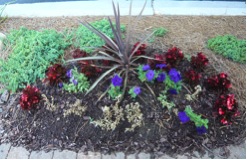 Figure 2. Mixed planting and improper crop rotation in two consecutive years. The petunias are exhibiting signs of disease in the first year (left photo) as well as the second year (right photo).
Figure 2. Mixed planting and improper crop rotation in two consecutive years. The petunias are exhibiting signs of disease in the first year (left photo) as well as the second year (right photo).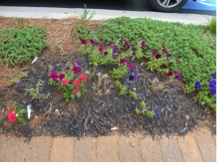
Crop rotation as it applies to seasonal beds simply means that landscapers should avoid planting the same species and cultivar of flowering crop, or crops belonging to the same family, in the same bed for more than two years. For example, petunias should not be followed with petunias because certain pathogens specific to petunias tend to accumulate and persist in the soil from year to year (Figure 2). Additionally, if ornamental tobacco is planted after petunia, it still could lead to plants being attacked by the same pathogens because the crops are closely related. This is of particular concern if the petunias were experiencing problems in the first year, which means that the pathogen is already in the soil and in sufficient quantity to cause damage.
Crop rotation is easier in monoculture (single species/cultivar planting in a bed); an example of a successful rotation is shown in Figure 3.
 Figure 3. A monoculture planting showing proper crop rotation. Top photo: first year, vinca; bottom photo: second year, begonia. The shape of the bed is symmetrical (the top photo is of right side of the bed, while the bottom photo is the left side).
Figure 3. A monoculture planting showing proper crop rotation. Top photo: first year, vinca; bottom photo: second year, begonia. The shape of the bed is symmetrical (the top photo is of right side of the bed, while the bottom photo is the left side).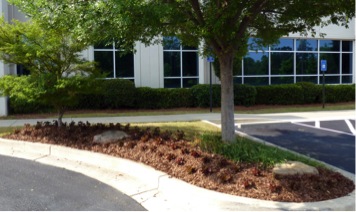
Mixed plantings are a common practice in seasonal color beds as the impact sought is achieved with three to five or more different species and/or cultivars with a range of bloom and foliage colors and growth habits. However, they present a challenge as the same bed may have representatives of three botanical families. For a successful crop rotation program, species from three different families should be planted the next year and the year after (Figures 4-5). In addition, grouping plants according to their cultural requirements is crucial to the health of the plants and success of the landscape.
 Figure 4. A mixed landscape planting in three consecutive years showing proper crop rotation. Left photo: first year, dragon wing begonias and alternanthera; middle photo: second year, lantana and elephant ears; right photo: third year, begonia, petunia and salvia.
Figure 4. A mixed landscape planting in three consecutive years showing proper crop rotation. Left photo: first year, dragon wing begonias and alternanthera; middle photo: second year, lantana and elephant ears; right photo: third year, begonia, petunia and salvia.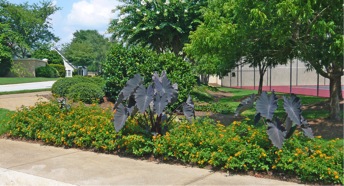
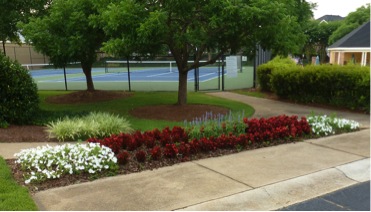
 Figure 5. A mixed planting showing good plant growth and no apparent signs of disease. Top photo: two weeks after planting; bottom photo: six weeks later.
Figure 5. A mixed planting showing good plant growth and no apparent signs of disease. Top photo: two weeks after planting; bottom photo: six weeks later.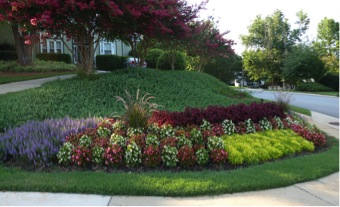
Applying crop rotation to seasonal landscape color beds will lead to lower disease incidence, lower replacement needs, lower pesticide applications and higher profit margins.
Table 3 lists the family scientific name and the common name of several warm- and cool-season annuals commonly found in landscaped areas. Landscapers should keep records of their seasonal color rotations and, in particular, note any problems that may have developed throughout the year.
| Table 3. Common annual flowering species and their corresponding botanical family. | |
| Family Name | Common Name |
| Amaranthaceae | Celosia (Spike Celosia, Cockscomb), Alternanthera (Joseph’s Coat) |
| Apiaceae | Parsley |
| Apocynaceae | Vinca (Periwinkle) |
| Araceae | Caladium, Alocasia, Colocasia (Elephant Ears) |
| Asteraceae | Aster, Marigold, Gazania, Mums, Sunflower, Black-eyed Susan, Echinacea, Zinnia, Mexican Sunflower, Melampodium, Ageratum |
| Balsaminaceae | Impatiens |
| Begoniaceae | Begonia |
| Brassicaceae | Alyssum, Ornamental Cabbage, Kale |
| Caryophyllaceae | Dianthus |
| Commelinaceae | Setcresea (Purple Heart) |
| Convolvulaceae | Potato Vine (Ipomoea), Morning Glory |
| Crassulaceae | Sedum |
| Geraniaceae | Geranium |
| Goodeniaceae | Scaevola (Fan Flower) |
| Lamiaceae | Coleus, Salvia, Mints |
| Lythraceae | Cuphea (Cigar Plant) |
| Plantaginaceae | Snapdragon |
| Poaceae | Grasses (e.g., Pennisetum) |
| Portulacaceae | Portulaca (Purslane) |
| Rubiaceae | Pentas (Shooting Stars) |
| Scrophulariaceae | Angelonia (Summer Snapdragon), Torenia (Monkey Flower) |
| Solanaceae | Petunia, Ornamental Tobacco, Ornamental Pepper, Browalia |
| Verbenaceae | Verbena, Lantana |
| Violaceae | Pansy, Viola |
Status and Revision History
Published on Dec 23, 2013
Published with Full Review on Sep 01, 2016
Published with Full Review on Apr 12, 2022


























































